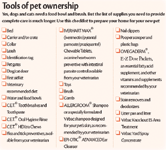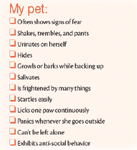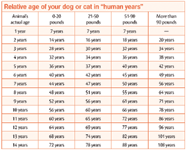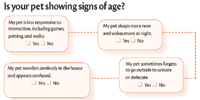A lifetime of love
You want your furry new bundle of joy to live a long, happy life by your side. To better prepare your new dog, cat, puppy, or kitten for a healthy future, there are some steps you can take up front to prevent health problems. Let's take a look at some of the ways you can show your love for your new family member and offer the care they need.
You want your furry new bundle of joy to live a long, happy life by your side. To better prepare your new dog, cat, puppy, or kitten for a healthy future, there are some steps you can take up front to prevent health problems. Let's take a look a some of the ways you can show your love for your new family member and offer the care they need.

Get in gear
You've fallen in love with that precious face and those big, adoring eyes. You're planning to snuggle on the couch, play fetch, and sit on the sunny window sill with your new friend. You're ready for happily ever after. It's hard to imagine that there could be a bump in your path to lifelong bliss with your new pet. Still 10 to 20 years of caring for an animal companion can bring surprises. The key is to prepare today and to look ahead.

As much as pet ownership is an emotional investment, it's also an ethical responsibility and a financial investment. Our pets are totally dependent upon us for all their health care needs. To properly care for your furry-tailed friend, you need to begin with the right supplies. Grab a shopping cart and use the checklist of tools on the facing page to help make your pet healthier, happier, and more comfortable as she transitions to life in her new home with you.

Tools of pet ownership
Training: Getting along together
You want to start off on the right paw with your new friend. Behavior training is the best way to understand your pet—and to make sure your pet understands you, too. By investing a little time and effort in behavior training now, you'll reap the rewards of a happier pet that understands your expectations. After all, the dining room rug isn't the perfect place for a potty break and your summer sandals are not chewy appetizers.
To make sure your pet's natural behaviors—chewing, barking, and scratching for starters—don't get her into trouble, you need to gently but firmly establish your role as leader and set guidelines for training. It's important to be fair, calm, and consistent to elicit the behavior you expect. Let's look at some socialization skills and tips to teach your cuddly friend a few manners.
Social networking
A well-trained pet is friendlier around the people you love most. You want your new family member to enjoy an enthusiastic pat from your young niece or the gentle touch of your elderly neighbor.

You also want your animal to tolerate firmer handling when you and other care providers need to clean her ears, brush her teeth, and offer grooming and veterinary services. You can teach her to be receptive to all kinds of handling with a little practice. Ask your veterinarian to recommend a behavior training program in your area that provides obedience training and socialization for your pet. And consider this advice:
- Make training a positive experience. When you reach for your pet, always use a friendly approach. It's never a good idea to hit your pet or grab her roughly at the muzzle, neck, or other parts of her body.
- Choose a quiet time to start handling exercises. Dinner time often works well, and you can use a bit of pet food as a reward. When your pet is calm, inspect her ears, mouth, paws, belly, and hair coat using a gentle touch. At first, keep your touches short—only a second or two. As your pet becomes accustomed to your touches she'll gradually allow longer handling. Use lots of praise as she tolerates your fiddling.
- Be consistent. This means using the same words and gestures for simple commands every time. For example, if you're teaching your dog to stay, you might combine the word "stay" with a simple hand gesture, like a flat palm held in front of your body. To keep the command consistent, you'd always use the word "stay"—not "stay, dog" or "stay there"—with the same gesture.
- Stop if you notice aggression or anxiety. Your pet may act aggressively for a number of reasons, including fear or an instinct to protect her territory. Or she may feel threatened by you, a friend or stranger, or another animal. Some common signs of aggression include growling, hissing, snarling, loud and quick barking, lunging, and, in extreme cases, biting and physical attacks.
If you notice any signs of aggression in your pet, be sure to consult your veterinarian or a behavior training expert. A consultant can help you plan a training approach that's right for your pet. And your veterinarian may be able to determine whether your pet's behavior is a sign of anxiety in need of medical attention.

Help for anxious pets
Fear can be a normal reaction to new or stressful situations, but some pets suffer from fear that's out of proportion to the situation. Use the checklist on the facing page to identify signs of anxiety in your pet. Check all that apply.

My pet
If your pet exhibits any of these signs, it's a good idea to see your veterinarian as soon as possible. Anxious pets may be suffering. And if their treatment is delayed, the problem may worsen.
Your veterinarian will perform a thorough examination and may recommend ANXITANE® (L-Theanine) Chewable Tablets, a nutritional supplement indicated to reduce anxiety problems in dogs and cats. ANXITANE Tablets reduce excessive fear and apprehension and helps the pet remain calm. Calm pets are better able to learn, which prepares your pet for the behavior and socialization training she needs. ANXITANE Tablets address specific types of fear:
- Fear of people
- Fear during walks
- Fear of other pets
- Fear following a change in family situation, including death, divorce, moving, or adoption.
- Episodic fear, including response to such experiences as grooming, veterinary visits, car travel, thunderstorms, and fireworks.
Remember, stress and anxiety can lead to aggression, and anxiety increases the risk of illness, including skin problems, digestive issues, and heart disease. So if you suspect your pet suffers from anxiety, act quickly to offer her relief.
Skin care: Healthy habits for your pet's skin
Grooming is much more than looking good and smelling sweet. It's a healthy lifestyle for your pet that includes regular baths and oral care to keep her skin, hair coat, and teeth healthy. Here's a look at some of the activities you can practice with your pet to help her enjoy optimum health—and maybe make her feel a little pampered too.
Start with the right tools
Your pet needs regular baths, just like you do. And just as you may use a different shampoo than your curly-haired Aunt Kate, pets may need different shampoos for their skin and hair coat.
Remember, your shampoo has special ingredients to keep your hair and scalp healthy, but your pet's fur coat has different needs. Shampooing is a healthy and necessary part of your pet's grooming regimen. And specially-formulated shampoos from Virbac help keep your pet's hair coat shiny and healthy skin because they contain Glycotechnology, which gives pets an extra coat of protection that:
- keeps bacteria and yeast from adhering to the skin. If bacteria can't stick, they can't reproduce and infect.
- helps reduce the incidence of inflammation, keeping animals much more comfortable and less itchy.
If your pet begins to scratch, chew, or lick areas of their skin more than occasionally, make sure to discuss this with your veterinarian. Excessive itchiness may have underlying causes, including skin allergies that your veterinarian can help you manage and keep your pet comfortable.
The Virbac line of shampoos include these specially-formulated products:
- ALLERGROOM® Shampoo, a hypoal-lergenic shampoo for routine use on dogs or cats. This specially-formulated shampoo is designed so it won't wash off your pet's topical flea and tick preventive.
- KERATOLUX® Shampoo, a tar-free medicated shampoo for use on pets with seborrheic skin conditions or excessively dry or oily skin.
- ETIDERM® Shampoo, a mild, antiseptic shampoo for routine use on dogs or cats. Your veterinarian can help you select the right shampoo for your canine companion based on your pet's skin and hair coat health.
Scrub a dub tub time
Once you have the right tools, it's time to roll up your sleeves and get down to the practical business of bathing your pet. Whether your pet is a born swimmer or sprinkler shy, you can make bath time a gentle, comfortable experience. Ready to pamper your pet? Here are a few tips as you prepare to give your pet the spa treatment:
Your pet might just try to wiggle her way out of your arms when you first turn the tap. For her safety—and yours—use extra caution on wet surfaces. It may also help to seek an assistant to hold the pet while you wash.
Bath time is the perfect time to clip and remove hair mats. It's also a good time for a pedicure. Your veterinarian may also recommend using a sterile ophthalmic ointment for eye protection during baths, so check with your veterinarian before you grab the shampoo.
Now you're ready to go. But where do you start? It's simple if you follow these eight easy steps.
1. Use lukewarm water to rinse your pet thoroughly. A hand-held shower head works best, because you can move around a stationary pet or move the spout to clean hard-to-reach areas if your pet wriggles or squirms.
2. Use enough shampoo to thoroughly lather the top of the neck and the back of your pet.
3. Make sure you avoid the face and ears. Wash these areas separately with a washcloth to avoid getting soap in your pet's eyes and ears. (We'll discuss ear cleaning in the next section.)
4. Work the shampoo into a rich lather, adding more lukewarm water as needed.
5. Allow the shampoo to sit for 5 to 10 minutes.
6. Rinse the shampoo thoroughly from your pet's fur until the water runs clear.
What about cats?
In many cases a cat may be difficult to bathe, but if it starts to experience unhealthy skin conditions, please make sure to discuss this with your veterinarian. Virbac has leave-on lotions that your veterinarian can recommend which can help your cat's skin without using a medicated shampoo, such as RESISOOTHE® Leave-On Lotion for dry, mildly-irritated skin.
Looking good, feeling great
Baths alone might not be enough to keep your pet's hair coat and skin shiny and healthy. Whether she's a show dog in the ring or a camera shy house cat, you can help her look and feel her best with a few additional steps.
Depending on your pet's breed and hair coat type, she may need extra care, from brushing and trimming to supplements that restore skin integrity and improve hair coat quality. Remember, pets come with different hair coats, from long-haired to short-haired and wiry, and some pets will shed more while others need regular trims and daily brushing. You'll want to select brushes and combs that cull out the loose fur, tangles, and gnarly mats and spread natural skin oils throughout the coat for a healthy shine.
Discuss your pet's grooming needs with your veterinarian and ask for recommendations to keep your pet's fur glistening with good health. In addition to regular grooming, your veterinarian may recommend an essential fatty acid supplement, such as OMEGADERM® Packets.This easy-to-use product is a unique veterinary formulation for dogs and cats that delivers high levels of omega-6 and omega-3 essential fatty acids along with Vitamins E and A. It comes in single serve packets that are applied to the pet's food to treat skin conditions and improve the smoothness of your pet's skin and the luster of her hair coat.
Listen up: Basic ear care
It's a good idea to regularly examine your pet's ears for signs of buildup or infection. You may notice an unpleasant odor, brown, waxy buildup, or discharge, or your pet may shake or scratch her head.
If you do find those soft, velvety ears are hiding a dirty little secret, ask your veterinarian to examine them. She can check for signs of infection and demonstrate proper cleansing techniques. She also may recommend a good ear cleaning product such as EPI-OTIC® ADVANCED Ear Cleanser.
When it's time to clean your pet's ears, start by filling the ear canal with the cleanser and massaging the solution into the ear. Then wipe the ear with gauze or a cotton ball. This will remove the wax buildup in the ear. Never use a cotton tipped applicator. This could damage the tender insides of your pet's ear.
Repeat the procedure until all of the dirt and debris is removed.
Sink your teeth into dental care
Your growing pet also needs regular dental care to keep her pearly whites shining bright. And you can support good oral health and prevent serious health problems in the future with proper dental care. Proper oral hygiene is more than just fresh smelling breath and sparkling teeth. Pets that don't receive dental care are at higher risk for serious illnesses, including dental disease and liver, kidney, and heart disease. Eighty-five percent of adult pets have periodontal disease.
Now that you know the risks, it's time to take action. Getting the right care and supplies now will help keep your pet's breath smelling fresh, so you won't mind when she plants a big wet one on your cheek. Let's look at three options to fight plaque-forming bacteria:
- Chews. C.E.T.® Chews satisfy your pet's natural desire to chew and prevent plaque buildup, keeping your pet's teeth clean. C.E.T. HEXtra ® Chews combine the mechanical activity of rawhide with the antiseptic power of chlorhexidine in a tasty chew your pet can't resist. And this yummy treat just might surpass your shoe as her chew of choice.
- Rinses and gels. Of course, brushing is best. But this step helps control tartar if you're struggling to get your stubborn pet to accept toothbrush-ing. C.E.T.® Oral Hygiene Rinses and Gels are easy to use—just apply between your pet's cheek and gum for plaque control. These products contain Zinc-Chlorhexidate™, a powerful, proven plaque-fighting agent.
- Toothbrush and toothpaste. Experts agree daily brushing is the best way to maintain your pet's oral health. C.E.T. Home Dental Care offers toothbrushes in various sizes and fun colors to fit your pet's mouth and your sense of style. C.E.T.® Toothpaste comes in the flavors your pet adores, from poultry, malt, or vanilla-mint to beef or seafood. Best of all, they contain a patented dual-enzyme system to inhibit plaque-forming bacteria, and they're specially-formulated so they're safe to swallow—just in case you have trouble teaching your pet to spit.
Heart healthy, heart happy
Parasite control is a critical health issue for your new pet. And parasites can mount an invisible assault on your pet—inside and out. But you have the power to safeguard your pet with preventives that reduce the risk of a potentially devastating or even life-threatening condition.
During your pet's first veterinary exam, your veterinarian will recommend an annual heartworm test. If your pet hasn't been on heartworm preventives before, testing ensures your dog or cat is healthy and ready to start a parasite prevention program. Please keep in mind that heartworms are undetectable in dogs less than 6 months old and kittens less than 7 to 8 months old, so testing may not be not needed right away. However, when your pet is old enough, a prevention program ensures your pet's safety. Signs of heart-worm disease include coughing, lethargy, weight loss, and exercise intolerance. If you notice these signs or your pet isn't currently on a parasite prevention program, see your veterinarian immediately.
Regardless of where you live, experts agree year-round heartworm prevention is best. Why? Because heartworm disease has been identified in all 50 states year-round. And pets today live active, healthy lives just like their owners. Their lifestyles often include trips with the family—whether it's a cross-country road trip or a jaunt down the road to the local puppy park. All these fun activities could expose your pet to heartworms. Once a pet is infected, heartworm is expensive to treat. Treatment for heartworm disease can also be hard on your pet. And left untreated heartworm can be fatal. Here's a case where consistent prevention is clearly the best medicine.
IVERHART MAX® (ivermectin/ pyrantel pamoate/praziquantel) Chewable Tablets contain drugs most recommended by veterinarians, prevents canine heart-worm infection and controls intestinal parasites. And it's safe for puppies as young as 8 weeks old, as well as nursing and pregnant dogs. All dogs should be tested for heartworm infection, before starting a preventive program. Following the use of IVERHART MAX® Chewable Tablets, digestive and neurological side effects have rarely been reported. Use with caution in sick, debilitated, or underweight dogs weighing less than 10 lbs. See package insert for additional information.

Intestinal parasites: An unseen foe
Besides heartworm infection, IVERHART MAX® Chewable Tablets are also effective against roundworms, hookworms, and tapeworms in dogs. Here's a look at these intestinal parasites and how they can affect your beloved pet:
- Roundworms are the most common intestinal parasites in dogs. They occupy the intestines of infected dogs, robbing them of nutrients and sometimes blocking the passage of food. Severe infections can result in damage to the lungs and liver. Roundworms infect dogs of any age, but they are especially dangerous to puppies. Signs of roundworm infection include diarrhea, lethargy, and a swollen abdomen.
- Hookworms are a danger to your dog because they feed by repeatedly removing small amounts of tissue from inside the small intestine, where they reside. This causes blood loss and inflammation and can lead to lethargy and malnutrition. Hookworms are primarily a disease in puppies but may cause disease in dogs of all ages. Signs of hookworm disease include diarrhea, lethargy, and black tar-like stool.
- Tapeworms are a repugnant find for pet owners. When pets are receiving heartworm prevention with a gastrointestinal dewormer added, you might wonder why you're seeing tapeworms. That's because most heartworm medications don't contain praziquantel, an active ingredient in IVERHART MAX® Chewable Tablets. Many dogs enjoy the taste of these chewable tablets, making it a simple solution for parasite prevention. Need help remembering to give this once monthly preventive? Visit www.iverhart.com to sign up for free e-mail reminders.
The veterinarian: Your link to a lifetime of care
Even a pet that looks healthy on the outside may suffer from medical problems or risk factors only a veterinarian can identify. That's why it's so critical for your pet to see the veterinarian for regular visits.
At your initial visit the veterinarian will perform a thorough physical examination that may include these procedures, depending on your pet's health and age:
- Listening to the heart and lungs
- Checking ears, eyes, and mouth
- Feeling your pet's abdomen to ensure there are no abnormalities
- Examining teeth for signs of dental disease
- Weighing your pet and calculating a body condition score.
The veterinarian may also perform these tasks at the initial visit:
- Vaccinating your pet
- Conducting a fecal test and de-worming your pet
- Testing your pet for a possible heartworm infection
- Recommending appropriate heartworm and intestinal parasite preventives, such as IVERHART MAX® Chewable Tablets
- Recommending appropriate flea and tick preventives
- Discussing the possibility of spaying or neutering your pet
- Recommending dental cleaning as necessary
- Assessing the pet's nutritional needs
- Assessing your pet's behavior
- Checking a urine sample.
In older pets, your veterinarian may also recommend these additional services based on your pet's examination and healthcare needs:
- Complete blood count and serum chemistry panel
- Thyroid check
- ECG
- Blood pressure measurement
- Eye pressure measurement
- Abdominal radiographs
- Thoracic (chest) radiographs.
These lists may include different services based on your veterinarian's care schedule and recommendations. If your pet ever becomes ill, additional examinations and diagnostic tests may be necessary.
The golden years
As your pet's whiskers whiten, you may notice she plays less, sleeps more, or urinates or defecates in the house. Don't look at these as normal signs of aging. Just like people, older pets that receive the proper preventive and medical care can stay young at heart for many years.
First, recognize that pets age faster than people; one human year is much longer in dog years. Your pet's age also relates to her size. For example, an 8-year-old miniature schnauzer that weighs 15 pounds is 48 years old in dog years. But an 8-year-old chocolate lab that weighs less than 70 pounds is likely closer to 55 years old. Use the helpful chart on this page to calculate your pet's age.

Relative age of your dog or cat in "human years"
If you suspect your older animal is suffering from brain aging, contact your veterinarian immediately. Early intervention can potentially avoid the need for certain drugs with possible side effects. Treatment is possible at all stages of brain aging but is more likely to be effective if you start early. You may be able to identify some of your pet's signs with the simple quiz above.

Is your pet showing signs of age?
If you answered yes to any of these questions, it's time to talk to your veterinarian about brain aging. Your veterinarian may recommend a product, such as NOVIFIT® (NoviSAMe®) Tablets. NOVIFIT Tablets may offer many benefits, such as increasing your pet's alertness and vitality, improving your relationship with your pet, and regulating your pet's sleep cycle. It may also reduce housesoiling and delay the consequences of aging, and it presents no known side effects.
Your veterinarian and your friends at Virbac Animal Health are your partners in pet care. We offer our support over the lifetime of care you'll offer your pet. And we wish you a lifetime of love with your new companion!
© 2009 Virbac Animal Health. All rights reserved. To view this publication online, visit www.dvm360.com/c73